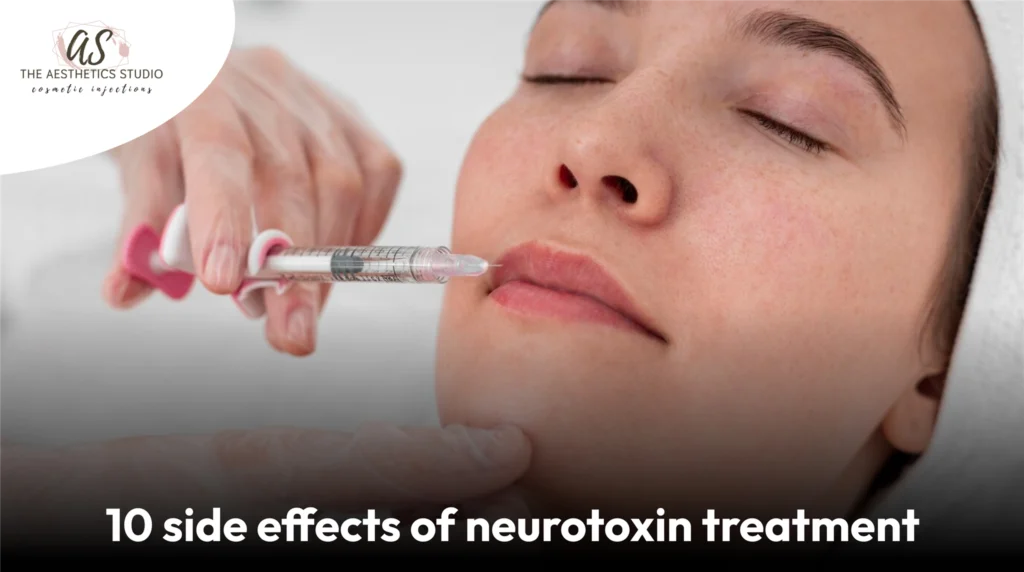What is neurotoxin treatment?
Neurotoxin treatment is a procedure for which doctors can provide medical and cosmetic reasons. Some of the procedures have been successful, while others have come to face challenging situations due to side effects. In this article, the reader will receive information on ten neurotoxin treatment side effects prior to having it done.
10 Side Effects of Neurotoxin Treatment
1. Temporarily Weak Muscles
Temporary weakness in muscles is one of those side effects that neurotoxin treatment often comes with. This works by blocking nerve signals to the muscles in question for some time, making them go weak for a while. The rear is helpful in some scenarios, but ask the protection physician on how this could implicate the muscles.
2. Injection site pain and discomfort
The neurotoxin may cause mild discomfort or even pain to some people after it has been injected. This is not serious in most cases and will work itself out in about two days. To get rid of that feeling, one can use ice packs or buy over-the-counter analgesics.
Read also: Crafting Your Aesthetic Symphony: Choosing the Perfect Dermal Filler
3. Bruising and Swelling
Other common side effects of neurotoxin treatment include pain and swelling. This is due to the injection process that can cause damage to the blood vessels and site of injection. Cold compresses and avoiding any physical exercises can help reduce these bruises.
4. Headaches
In some instances, people may get a headache after being treated with neurotoxins. Such headaches are usually mild and last for a short time. It is advised to drink enough water, take rest, and, if necessary, use over-the-counter pain medications. Consultation is required when such headaches continue or become worse.
5. Flu-Like Symptoms
In some cases, after treatment with neurotoxins, one may develop flu-like symptoms such as fever, tiredness and muscle pain. Usually, these symptoms are temporary and fade away within a few days. They can be managed by drinking a lot of fluids, taking enough rest and using non-prescription anti-fever drugs.
| Craving a Painless Beauty Upgrade? Click to Book Your Neurotoxin Treatment! |
6. Drooping Eyelids or Eyebrows
To further explain, neurotoxin treatment can also cause a temporary drooping of the eyelids or eyebrows. This takes place if the neurotoxin injected extends out of its target region. Although rare, it is advisable to discuss this potential risk with your healthcare provider before any procedure is done.
7. Dry Eyes
One of the possible outcomes of treatment with neurotoxins, which are administered through injections around the eyes, is temporary dryness. This happens because the toxins affect muscles that cause tears in the eyes. Artificial tears or lubricating eye drops may assist in reducing dryness and relieving it.
8. Difficulty Speaking or Swallowing
In rare cases, a few people can have temporary difficulty speaking or swallowing after being given neurotoxin treatments. Typically, this side effect arises when the dose is higher, or the injection is done in specific muscles. Someone must immediately call for help from their doctor if they encounter such complications.
9. Allergic Reactions
It is not common, but one can get allergic reactions to neurotoxin treatments. Some of the symptoms of an allergic reaction may include itching, rashes, hives, swelling, and shortness of breath. Suppose you notice these signs in yourself or someone else. In this case, it is best to seek immediate medical attention for proper management.
Read also: 10 Incredible Benefits of Dermal Filler Treatment | Your Studio Wellness
10. Unsatisfactory Results
Finally, let me make it known that the effects of neurotoxin treatment vary from one person to another. Most people see positive results; however, some do not experience satisfaction. This dissatisfaction may be addressed through discussing fears with one’s physician, having reasonable hopes and exploring future modes of therapy.
Conclusion
Considering Neurotoxin Treatment for medical or cosmetic purposes involves understanding potential benefits and risks. While these treatments can address various issues, such as muscle weakness, pain, or swelling, there are potential side effects like headaches, drooping eyelids, and allergic reactions. To make informed decisions, it is crucial to consult with a healthcare provider who can provide personalized advice based on your health status and goals. This ensures that you are well aware of the procedure’s implications and can minimize potential adverse effects. If you want to explore neurotoxin procedures further, visit The Aesthetics Studio. It’s essential to consult healthcare professionals for comprehensive information tailored to your needs. Book an appointment to discuss potential benefits, associated risks, and whether these treatments align with your health objectives.
Frequently Asked Questions:
Q1. Are the side effects of neurotoxin treatment permanent?
No, most side effects are temporary and subside within a few days to weeks.
Q2. Can anyone undergo neurotoxin treatment?
It is essential to consult a healthcare professional to determine if the treatment is suitable for your circumstances.
Q3. Can neurotoxin treatment be reversed if I am not satisfied with the results?
In some cases, the effects of neurotoxin treatment can be reversed using specific medications or waiting for the effects to wear off naturally.
Q4. How long do the results of neurotoxin treatment typically last?
The duration of results varies from person to person but typically lasts between three to six months.
Q5. Are there any long-term side effects of neurotoxin treatment?
No, long-term side effects of neurotoxin treatment are infrequent. Still, it is always important to discuss any concerns with your healthcare provider.













